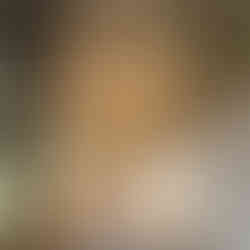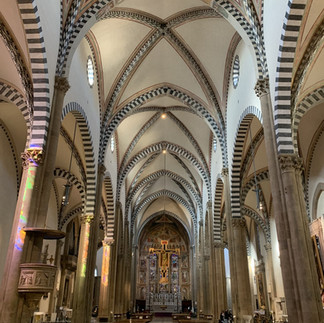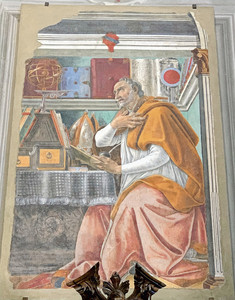
Like many Italian cities, Florence has hundreds of churches, from the massive Duomo to tiny hidden chapels, and it's hard to know which ones to visit or what to look for if you step inside. Here's my personal take on the historic churches and chapels of Florence. It's not complete but it's pretty close!
First, a word on terminology: Duomo is the Italian word for Cathedral (which indicates the seat of a Bishop, and there is only one per Diocese). It is from the Latin domus or house (of God). A Basilica in Ancient Roman times referred to a large civic building that housed the courts and other public offices, but is now "any church named highly important by the pope based on its historical or cultural importance, its art or beauty, [or] significance in the liturgical life of the Church"(1).
THE BIG ONES: These are also considered museums and you pay to enter
1) The Cathedral or Duomo di Santa Maria del Fiore

The Duomo is one of the most famous churches in the world, in large part because of the massive cupola or dome (please don't confuse "dome" with "duomo"!) designed by the Renaissance architect Filippo Brunelleschi. One of my top suggestions for visitors is to climb to the top of the cupola for awesome views and the chance to walk through the ingenious double layer of brick that allowed a dome of that size to not collapse in on itself.
Of course you must be very fit to climb to the top as there are 400+ steps and NO ELEVATOR. On your way up you also get to see the elaborate Heaven & Hell fresco cycle by Vasari:
And you get a great view down into the main body of the church:

You can also climb the 14th c. Bell Tower designed by the artist Giotto, which is still on my "to do" list!
** Related: Until the Renaissance, most baptistries had to be outside of the church as you weren't allowed to go inside until you had been baptized. These buildings are often as grand as the church they are paired with.

Florence's Baptistry is one of the oldest buildings in the city -- it was consecrated in the mid-11th c! -- and has a distinctly older style, including stunning Byzantine-style mosaics in the domed ceiling. The massive bronze doors on the eastern side were added later, by the Renaissance artist Lorenzo Ghiberti.

This is my favorite church in the city to re-visit and spend time in, since it has a warm and rich interior along with some magnificent frescoes, from Medieval to the Renaissance master Ghirlandaio, spread throughout not just one but two cloisters.
** Related: The monks of Santa Maria Novella used to cultivate herbs and plants for use as medical treatments as well as soaps and alcoholic elixirs (as many monastic communities did at the time), and this tradition continues in the "Officina Profumo Pharmaceutica." Located behind the 2nd cloister (with a separate entrance around the corner), it's one of the most beautiful shops in the city and it smells dreamy!

It's also known for its dramatic entryway, adorned with a changing display of dried flowers.
And thrown in for good measure, more Medieval frescoes!

There's also a huge book on medicinal plants in a glass case, and I was thrilled to find it open to the SAGE page (see: my new company, Wild Sage!)

3) The Basilica of Santa Croce This Franciscan church also has a rich interior, and holds the tombs of some of the city's star players like Michelangelo, Galileo and Machiavelli (there is a cenotaph of Dante -- an empty tomb -- since his body is in Ravenna, where he died). It's also the site of the annual Christmas market!

There's also a quiet cloister and Brunelleschi's very Renaissance Pazzi Chapel
4) The Basilica of San Lorenzo This church looks unassuming from the outside as its "grand façade" is just rough brick. It would have had a spectacular marble façade designed by none other than Michelangelo, but it was never completed.

Inside you find a Renaissance marvel, designed by Brunelleschi (the guy who did the Duomo's dome) for the powerful Medici family.
In the basement is the tomb of Cosimo "il Vecchio" (1389-1464), the astute businessman who made Florence one of the most influential cities in Europe and helped usher in the Renaissance:

** Related: The rest of the powerful Medici family are buried in elaborate tombs in a chapel adjoined to the back of San Lorenzo church. Some of the statues are by Michelangelo.

5) The Basilica of Santo Spirito

This Augustinian church is another one with a simple façade, but like San Lorenzo it was designed by Renaissance master Brunelleschi. Inside is all columns and geometry on display, with a crucifix by Michelangelo.
** Related: Piazza Santo Spirito, in the Oltrarno area ("other side of the Arno"), is a lively and leafy square with lots of restaurants and cafes, and weekly outdoor markets.

6) The Church of Orsanmichele is quite unique as it's housed on the ground floor of a 3-story building that also held the offices and even storage for some of the city's trade guilds.

The ground floor holds a sumptuous church and the upper floors display the original statues that used to adorn the outside -- many of them the patron saints of each guild.
7) The Brancacci Chapel, in the Basilica del Carmine, has one of the most famous fresco cycles in the city. Considered the first true example of Renaissance perspective, a 21-year-old painter named Masaccio worked on them in 1425-27 and they were eventually finished by Filippo Lippi after Masaccio's untimely death at only 27.
OTHER CHURCHES: these are free to enter but are no less historic or beautiful
8) The Basilica of San Miniato al Monte is one of the oldest churches in the city (11th c.) and sits on a hill just south of the Arno. It's still a functioning monastery.

The beautiful façade and sober interior make it a gem of Medieval architecture, and the monks sing the evening Vespers in Gregorian chant! It's well worth the trek up (you can also take a bus).
** Related: surrounding the church is a monumental cemetery (some in front but a ton in the back) which has some beautiful and touching tombs and mausolea.
It's right behind the Piazzale Michelangelo scenic overlook and has an amazing view, itself!:

9) The Basilica of San Marco is the church associated with the Convent of the same name (now a museum), which is famous for its association with the painter Fra' Angelico as well as the fire-and-brimstone preacher Savanarola. You can visit the church for free.

It's in stately Neoclassical style but has some earlier artworks, like this interesting mosaic of the Virgin from the 8th c. It's amazing how much she resembles the Empress Theodora, wife of the Byzantine Emperor Justinian, as portrayed in a church in Ravenna from the 6th c!
** Related: visit the Convent and see the monks' cells and some famous works by Fra' Angelico like this Annunciation:

10) The Basilica of Santissima Annunziata is in the piazza of the same name and is pure Baroque splendor (I felt like I was back in Palermo!):

As a bonus, there are fabulous Renaissance frescoes in the entry cloister by Andrea del Sarto:

** Related: the Ospedale degli Innocenti (Hospital of the Innocents) is next door and used to be a hospital that took in orphaned children (it had the famous "Lazy Susan"window where you could slide your child in without being seen from inside). It's now a museum and often has cool art exhibits.

11) The Church of Santa Trinita' Located at the beginning of the chic Via Tornabuoni (where all the designer shops are, including Ferragamo which is just across the square), this church is free to enter and has a host of beautiful works by artists such as Ghirlandaio, Desiderio da Settignano, Luca della Robbia and Neri di Bicci.

12) The Church of Santa Felicita' Located just south of the Ponte Vecchio, this became the family church of the Medici family after Cosimo 1st and his wife Eleonora of Toledo moved south of the river to the Pitti Palace. Cosimo had a private elevated corridor built to connect his palace with the City Hall so he wouldn't have to mingle with the people below, and it passed directly through the top of the church! This way they could worship away from prying eyes (or assassins' plots!). It has a sober, geometric interior as well as a masterpiece of Mannerist painting by Pontormo:
13) The Church of Ognissanti Here is another church with a few surprises inside, including the tomb of Sandro Botticelli (who was from this neighborhood) and the explorer Amerigo Vespucci, who gave his name to the Americas. There are two fabulous frescoes facing each other on the main aisle:
** Related: the Last Supper by Ghirlandaio is in this church complex but has another (paying) entrance. I've never been there during opening hours so haven't seen it yet!
14) Dante's Church (Santa Margherita de' Cerchi) Italy's most famous poet, Dante Alighieri, was from Florence, and you can visit his (supposed) house and church just a few blocks south of the Duomo.

This is thought to be the church where Dante met his beloved Beatrice, a central figure in his Divine Comedy, and there is a grave stone bearing her name in the small and sober space. Young lovers leave notes and "love locks" in her honor or asking for help in affairs of the heart. Out front, you may see Dante himself reading from his magnum opus.
This small church is just around the corner from Dante's church and offered alms to "the shamed poor," or formerly wealthy people who fell on hard times and were embarrassed to ask for help. A series of frescoes shows them treating the sick and burying the dead, and a plaque outside promised over 2,000 years of indulgences (!) for those who donated. There was also a small door for distributing bread during the Plague of 1522.
16) The Badia Fiorentina This is the oldest church in Florence as it was founded in 978. It's across the street from the Bargello museum and has undergone many architectural changes since its founding. It's still home to the Brotherhood of Jerusalem, a community of nuns and monks, so retains a very devout aspect.

17) The Cloister dello Scalzo This final entry is a small and almost unknown cloister featuring 16th c. frescoes by Andrea del Sarto. It's all that remains from a complex belonging to the Brotherhood of St. John the Baptist, which was suppressed in the 18th c. when many religious orders were disbanded. My artist friend Melissa loves the space and takes her drawing students here to study the delicate works. It's not often open so stop in if you see the door open!

-----------------------------------------
OTHER:
Florence also has a synagogue:

There is also a Greek Orthodox church and a Russian Orthodox Church that's pretty easy to recognize:

Other churches I have not yet visited: Sant'Ambrogio San Remigio
If you want to see Tuscany with me, you can choose one of our marvelous itineraries with Wild Sage (here's the Classic Tuscany tour) or ask us to set up something special for you and your friends or family.
TOUR UPDATE: I had a great spring tour season with two big Sicily tours (and more research on a new walking tour there) followed by a week scouting in Istanbul. I've got a few private trips scheduled over the summer and then start my Fall season, with a Naples-Amalfi combo, an Istanbul Explorer, and then our marvelous new Morocco tour. My colleague Manu has two different Dolomites hiking itineraries running this summer (the Val Funes & Rendena and the classic Val Gardena & Ampezzo) and will go up to Piedmont for two gourmet culinary (and walking) tours in the Fall as well as a tour around Lucca, Tuscany.
And 2025 is already looking great! We're offering another Cuba cultural tour in Feb/March 2025 and we have a brand-new Cuba walking tour there too! We're planning a Portugal multi-sport and Greek island tour in June, a Spain "light active" (no hiking) in the Fall, plus another Morocco! Thanks for joining me for some "armchair travel" here in the blog, and let me know if you'd like some real-life adventures! You know where to find me 😉
Ciao e alla prossima!















































































































Comments